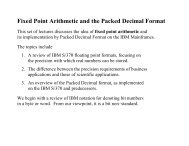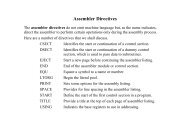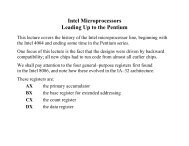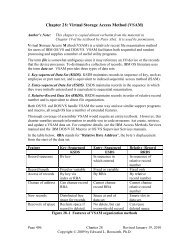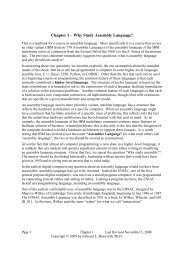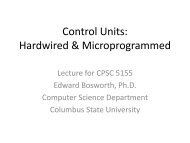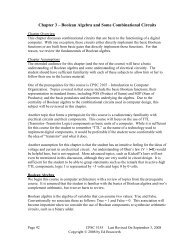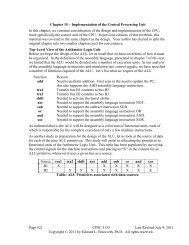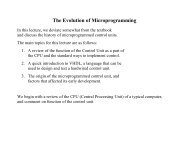Useful Number Systems - Edwardbosworth.com
Useful Number Systems - Edwardbosworth.com
Useful Number Systems - Edwardbosworth.com
Create successful ePaper yourself
Turn your PDF publications into a flip-book with our unique Google optimized e-Paper software.
<strong>Useful</strong> <strong>Number</strong> <strong>Systems</strong><br />
Decimal Base = 10<br />
Digit Set = {0, 1, 2, 3, 4, 5, 6, 7, 8, 9}<br />
Binary Base = 2<br />
Digit Set = {0, 1}<br />
Octal Base = 8 = 2 3<br />
Digit Set = {0, 1, 2, 3, 4, 5, 6, 7}<br />
Hexadecimal Base = 16 = 2 4<br />
Digit Set = {0, 1, 2, 3, 4, 5, 6, 7, 8, 9, A, B, C, D, E, F}<br />
Common notation:<br />
Leading 0 denotes octal 077 is an octal number, same as decimal 63<br />
Leading 0x denotes hexadecimal 0x77 is hexadecimal (decimal 119)
Binary, Decimal, and Hexadecimal Equivalents<br />
Binary Decimal Hexadecimal<br />
0000 0 0<br />
0001 1 1<br />
0010 2 2<br />
0011 3 3<br />
0100 4 4<br />
0101 5 5<br />
0110 6 6<br />
0111 7 7<br />
1000 8 8<br />
1001 9 9<br />
1010 10 A<br />
1011 11 B<br />
1100 12 C<br />
1101 13 D<br />
1110 14 E<br />
1111 15 F
Conversion Between Binary and Hexadecimal<br />
This is easy, just group the bits. Recall that<br />
A = 1010 B = 1011 C = 1100<br />
D = 1101 E = 1110 F = 1111<br />
Problem: Convert 10011100 to hexadecimal.<br />
1. Group by fours 1001 1100<br />
2. Convert each group of four 0x9C<br />
Problem: Convert1111010111 to hexadecimal.<br />
1. Group by fours (moving right to left) 11 1101 0111<br />
Group by fours 0011 1101 0111<br />
2. Convert each group of four 0x3D7<br />
Problem: Convert 0xBAD1 to binary<br />
1. Convert each hexadecimal digit: B A D 1<br />
1011 1010 1101 0001<br />
2. Group the binary bits 1011101011010001
Conversion Between Binary and Decimal<br />
Conversion between hexadecimal and binary is easy because 16 = 2 4 .<br />
In my book, hexadecimal is just a convenient “shorthand” for binary.<br />
Thus, four hex digits stand for 16 bits, 8 hex digits for 32 bits, etc.<br />
But 10 is not a power of 2, so we must use different methods.<br />
Conversion from Binary to Decimal<br />
This is based on standard positional notation.<br />
Convert each “position” to its decimal equivalent and add them up.<br />
Conversion from Decimal to Binary<br />
This is done with two distinct algorithms, one for the digits to the left of<br />
the decimal point (the whole number part) and one for digits to the right.<br />
At this point we ignore negative numbers.
Powers of Two<br />
Students should memorize the first ten powers of two.<br />
2 0 = 1<br />
2 1 = 2 2 –1 = 0.5<br />
2 2 = 4 2 –2 = 0.25<br />
2 3 = 8 2 –3 = 0.125<br />
2 4 = 16 2 –4 = 0.0625<br />
2 5 = 32 2 –5 = 0.03125<br />
2 6 = 64 etc.<br />
2 7 = 128<br />
2 8 = 256<br />
2 9 = 512<br />
2 10 = 1024<br />
10111.011 = 12 4 + 02 3 + 12 2 + 12 1 + 12 0 + 02 -1 + 12 -2 + 12 -3<br />
= 116 + 08 + 14 + 12 + 11 + 00.5 + 10.25 + 10.125<br />
= 23.375
Conversion of Unsigned Decimal to Binary<br />
Again, we continue to ignore negative numbers.<br />
Problem: Convert 23.375 to binary. We already know the answer.<br />
One solution.<br />
23.375 = 16 + 4 + 2 + 1 + 0.25 + 0.125<br />
= 12 4 + 02 3 + 12 2 + 12 1 + 12 0 + 02 -1 + 12 -2 + 12 -3<br />
= 10111.011<br />
This solution is preferred by your instructor, but most students find it<br />
confusing and prefer to use the method to be discussed next.<br />
Side point:<br />
Conversion of the above to hexadecimal involves grouping<br />
the bits by fours as follows:<br />
Left of decimal: by fours from the right<br />
Right of decimal: by fours from the left.<br />
Thus the number is 00010111.0110, or 0001 0111.0110 or 0x17.6<br />
But 0x17.6 = 116 + 71 + 6/16 = 23 + 3/8 = 23.375
Conversion of the “Whole <strong>Number</strong>” Part<br />
This is done by repeated division, with the remainders forming the binary<br />
number. This set of remainders is read “bottom to top”<br />
Quotient Remainder<br />
23/2 = 11 1 Thus decimal 23 = binary 10111<br />
11/2 = 5 1<br />
5/2 = 2 1 Remember to read the binary<br />
2/2 = 1 0 number from bottom to top.<br />
1/2 = 0 1 As expected, the number is 10111<br />
Another example: 16<br />
Quotient Remainder<br />
16/2 = 8 0<br />
8/2 = 4 0<br />
4/2 = 2 0 Remember to read the binary<br />
2/2 = 1 0 number from bottom to top.<br />
1/2 = 0 1 The number is 10000 or 0x10
Convert the Part to the Right of the Decimal<br />
This is done by a simple variant of multiplication.<br />
This is easier to show than to describe. Convert 0.375<br />
<strong>Number</strong> Product Binary<br />
0.375 x 2 = 0.75 0<br />
0.75 x 2 = 1.5 1 Read top to bottom as .011<br />
0.5 x 2 = 1.0 1<br />
Note that the multiplication involves dropping the leading ones from the product<br />
terms, so that our products are 0.75, 1.5, 1.0, but we would multiply only the<br />
numbers 0.375, 0.75, 0.50, and (of course) 0.0.<br />
Another example: convert 0.71875<br />
<strong>Number</strong> Product Binary<br />
0.71875 x2 = 1.4375 1<br />
0.4375 x 2 = 0.875 0 Read top to bottom as .10111<br />
0.875 x 2 = 1.75 1 or as .1011100000000 …<br />
0.75 x 2 = 1.5 1 with as many trailing zeroes as you like<br />
0.5 x 2 = 1.0 1<br />
0.0 x 2 = 0.0 0
Convert an “Easy” Example<br />
Consider the decimal number 0.20. What is its binary representation?<br />
<strong>Number</strong> Product Binary<br />
0.20 2 = 0.40 0<br />
0.40 2 = 0.80 0<br />
0.80 2 = 1.60 1<br />
0.60 2 = 1.20 1<br />
0.20 2 = 0.40 0<br />
0.40 2 = 0.80 0<br />
0.80 2 = 1.60 1 but we have seen this – see four lines above.<br />
So 0.20 decimal has binary representation .00 1100 1100 1100 ….<br />
Terminating and Non–Terminating <strong>Number</strong>s<br />
A fraction has a terminating representation in base–K notation only if the<br />
number can be represented in the form J / (B K )<br />
Thus the fraction 1/2 has a terminating decimal representation because it is<br />
5 / (10 1 ). It can also be 50 / (10 2 ), etc.
More on Non–Terminators<br />
What about a decimal representation for 1/3?<br />
If we can generate a terminating decimal representation, there must be positive<br />
integers J and K such that 1 / 3 = J / (10 K ). But 10 = 25, so this be<strong>com</strong>es<br />
1 / 3 = J / (2 K 5 K ).<br />
Cross multiplying, and recalling that everything is a positive integer, we have<br />
3J = (2 K 5 K )<br />
If the equation holds, there must be a “3” on the right hand side. But there<br />
cannot be a “3” on this side, as it is only 2’s and 5’s.<br />
Now, 0.20 = 1 / 5 has a terminating binary representation only if it has a<br />
representation of the form J / (2 K ).<br />
This be<strong>com</strong>es 1 / 5 = J / (2 K ), or 5J = 2 K . But no 5’s on the RHS.<br />
Because numbers such as 1.60 have no exact binary representation, bankers and<br />
others who rely on exact arithmetic prefer BCD arithmetic, in which exact<br />
representations are possible.



